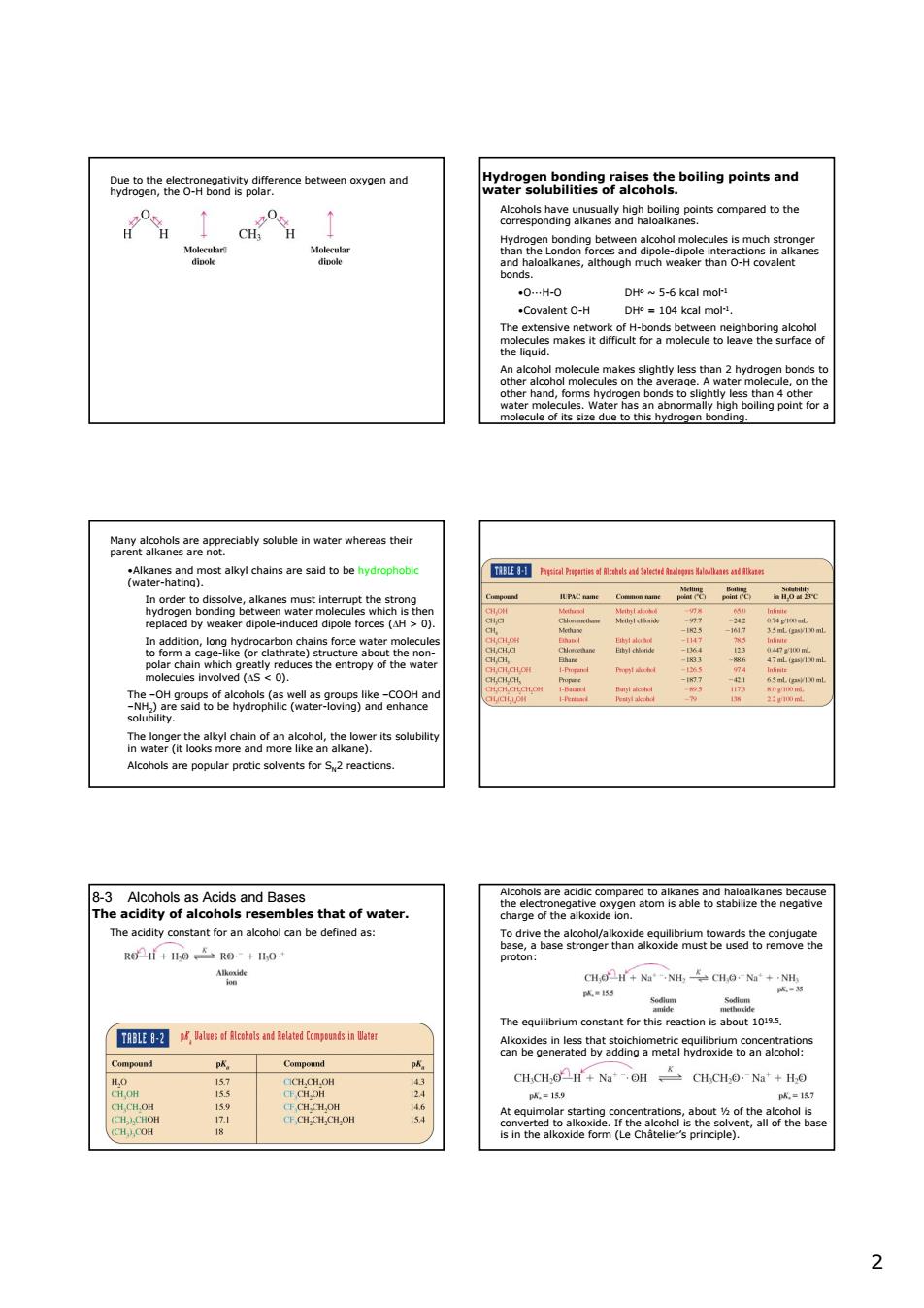正在加载图片...

ohet0H83aydarencebetwenomygenand Hgdee8nubandeaoiesnhe.boingpointsand orap5hggm522hieentcomparedtothe and hal DHte ~5-6 kcal mol .Covalent O-H DH 104 kcal mol other en吗Tot 88 neettangfnkcaheaersoub Aohols are pua proticsovor B3anoaiconan6neshatofwater The acidity constant for an alcohol can be defined as: Re+R+HO n8e股8e5。 aw←a0 The ea CHCHo f+Na-OH CHCHONa'+HO 22 Due to the electronegativity difference between oxygen and hydrogen, the O-H bond is polar. Hydrogen bonding raises the boiling points and water solubilities of alcohols. Alcohols have unusually high boiling points compared to the corresponding alkanes and haloalkanes. Hydrogen bonding between alcohol molecules is much stronger than the London forces and dipole-dipole interactions in alkanes and haloalkanes, although much weaker than O-H covalent bonds. •O···H-O DHo ~ 5-6 kcal mol-1 •Covalent O-H DHo = 104 kcal mol-1. The extensive network of H-bonds between neighboring alcohol molecules makes it difficult for a molecule to leave the surface of the liquid. An alcohol molecule makes slightly less than 2 hydrogen bonds to other alcohol molecules on the average. A water molecule, on the other hand, forms hydrogen bonds to slightly less than 4 other water molecules. Water has an abnormally high boiling point for a molecule of its size due to this hydrogen bonding. Many alcohols are appreciably soluble in water whereas their parent alkanes are not. •Alkanes and most alkyl chains are said to be hydrophobic (water-hating). In order to dissolve, alkanes must interrupt the strong hydrogen bonding between water molecules which is then replaced by weaker dipole-induced dipole forces (ΔH > 0). In addition, long hydrocarbon chains force water molecules to form a cage-like (or clathrate) structure about the nonpolar chain which greatly reduces the entropy of the water molecules involved (ΔS < 0). The –OH groups of alcohols (as well as groups like –COOH and –NH2) are said to be hydrophilic (water-loving) and enhance solubility. The longer the alkyl chain of an alcohol, the lower its solubility in water (it looks more and more like an alkane). Alcohols are popular protic solvents for SN2 reactions. 8-3 Alcohols as Acids and Bases The acidity of alcohols resembles that of water. The acidity constant for an alcohol can be defined as: + - 3 -1 a2 a [H O ][RO ] K = K[H O] = mol L , and pKa = -log K [ROH] Alcohols are acidic compared to alkanes and haloalkanes because the electronegative oxygen atom is able to stabilize the negative charge of the alkoxide ion. To drive the alcohol/alkoxide equilibrium towards the conjugate base, a base stronger than alkoxide must be used to remove the proton: The equilibrium constant for this reaction is about 1019.5. Alkoxides in less that stoichiometric equilibrium concentrations can be generated by adding a metal hydroxide to an alcohol: At equimolar starting concentrations, about ½ of the alcohol is converted to alkoxide. If the alcohol is the solvent, all of the base is in the alkoxide form (Le Châtelier’s principle)